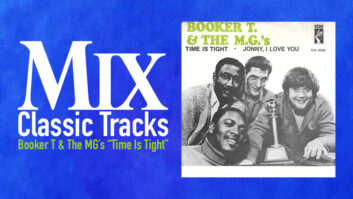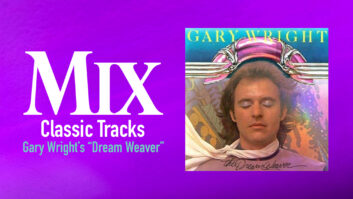
Not too many people these days know about the Chamber Brothers, but when their first Columbia album, The Time Has Come, was released in late 1967, it was a very big deal.
The closing track on that record, an 11-minute rock-soul-psychedelic freak-out called “Time Has Come Today,” got heavy, heavy airplay on the first wave of “underground” FM rock stations, which were no longer bound by the restrictions of AM pop or R&B radio. And an edited version of the song released in the summer of 1968 was a bona fide hit single, played on AM and FM stations all over the country. Though it never cracked the Top 10 nationally (it did in several markets), it sat at Number 11 for an impressive five weeks, The Time Has Come album rocketed all the way up to Number 4, and the Chambers Brothers were transformed into concert headliners.
As usual with these “overnight success” stories, it was many years in the making. The Chambers Brothers started out in the early ’50s singing gospel music in a Baptist church in their native Mississippi, where the family worked as cotton sharecroppers. In 1952, the eldest of the singing brothers, George, was drafted into the Army, and when his tour of duty ended a couple of years later, he settled in L.A.—and the rest of the family (12 brothers and sisters and their parents) soon followed.
During the late ’50s, the four singing Chambers—George, Joe, Willie and Lester—mostly sang in churches around L.A., but by 1961, they had started to land paying gigs as The Chambers Brothers around town, singing a mixture of gospel, blues and folk tunes in coffee houses and small clubs for predominantly white audiences. Joe and Willie played acoustic guitar, George was on washtub bass and Lester on harmonica, but this group was really all about the rich gospel harmonies. They built a following at the famous L.A. club the Ash Grove, and it was there that they began a fruitful association with the great folk, blues and jazz singer Barbara Dane, who took them on tour with her, cut an album with them, and helped them land prestigious gigs on the East Coast, particularly in New York and Boston (which became a second home for them). In 1965, they switched to electric instruments and also hired a fantastic white drummer—Brian Keenan—making them one of the pioneering interracial bands.
An up-and-coming 23-year-old staff producer for Columbia Records named David Rubinson first saw the Chambers Brothers at a gig in New York in 1965 and immediately wanted to sign them. Easier said than done. They had two managers in different cities, a deal with Vault Records from which they needed to be extricated and no publishing company handling their original material—not that they had much of that at that point. Once those issues had been dealt with, Clive Davis let Rubinson sign the band to Columbia and he found himself heading out to L.A. to work with the band.
“They were living on West Adams Boulevard in the Crenshaw area of Los Angeles, a big old house with tons of people coming in and out,” Rubinson says by phone from his home in a small village in France. “There must have been 10 or 15 people there—girlfriends, family, friends—and that’s where I worked with them because they rehearsed there. I went to as many of their live gigs as possible to get a sense of their material and what they were like—because I wasn’t looking to change them, I was looking to capture them. But the big question was the songs, because what they were doing then was mostly covers—they were singing Isley Bothers’ ‘Shout’ and blues songs and [Curtis Mayfield’s] ‘People Get Ready’ and [Wilson Pickett’s] ‘Midnight Hour.’ They hadn’t written a lot. But then when they got into this rehearsal situation they started writing more.”
On August 1, 1966, the Chambers Brothers went into Columbia L.A.’s Studio B to cut a song that guitarists Joe and Willie had written called “Time Has Come Today.” It was driving rock with a soul twist, “different than anything else going on,” Rubinson says. “They were completely out of the mold.” It had a certain urgency to it, but was still fun. And it also contained a line that captured some of the zeitgeist of the emerging hippie counterculture: “My soul has been psychedelicized!”
It was Rubinson who conceived of the famous tick-tock cowbell that goes through the song—played by Lester—and he also came up with the bizarre, piercing electric harpsichord part which helped define this early version. That was an overdub, but otherwise, “I always recorded the Chambers Brothers live; we did very few overdubs. Their energy was so strong, and it was such a synergy, that to lay down a track and then sing over it was completely foreign; it didn’t make any sense.” This first version clocked in at just 2:40 and “it didn’t slow down, it didn’t go psychedelic, it didn’t have the reverb and all that,” Rubinson notes.
In those days, it was Clive Davis and Columbia’s policy to introduce a new artist through singles, and then if one clicked, the act was allowed to cut a full album. Unfortunately this first version of “Time Has Come Today” was not a commercial success. “We recorded three or four other songs as singles,” Rubinson says, “and a couple of them made a small dent on radio—‘I Can’t Stand It,’ ‘All Strung Out Over You.’ We were chasing singles, which was really a mistake, but we did it. I begged and begged for Columbia to put out an album, and the main reason was that radio was changing. That meant we weren’t stuck with Top 40 radio, and as a result we had a place to put an album that wasn’t aimed at that.”
Through the first half of 1967, the Chambers Brothers toured relentlessly “and built up a big following around the country,” Rubinson says. “They would pack into a station wagon and drive from city to city and play these gigs. They’d play ‘Time Has Come Today’ live, and they developed this whole thing where it would slow down with the cowbell, and they’d have this incredible electric jam in the middle, and it would go way out there and craziness would ensue, and then they’d bring it back to the song and be done 20 minutes later. When I saw them at the Electric Circus [a hip club in NYC], it was mind-blowing; everyone went nuts over it.”
Shortly after that appearance, in early August 1967, the band went into Columbia New York’s Studio E with Rubinson and engineer Fred Catero and cut the epic psychedelic version of “Time Has Come Today” that would appear on The Time Has Come, completely live—trippy sound effects included—in just one take.
Studio E was “smallish, probably 20-by-30, but it sounded great,” Rubinson says. “I worked there a lot in those days. At the heart of control room was what Catero calls “a wonderful-sounding” custom Columbia 12-input console “with rotary knobs, instead of faders, and fantastic pre’s and EQs—all tube—that were in a rack behind; there were no electronics in the board itself; it was more like a control surface.” Catero doesn’t recall specific mic choices he might have made, but believes “it was probably a lot of Neumanns; they had a great collection.” The session was recorded to 8-track one-inch Ampex, with three mics on Brian Keenan’s drums mixed down to mono and placed on the left side of stereo spread, one channel each for guitars and bass, and four for the vocals (one of them also handling the famous cowbell).
Rubinson and Catero did some pre-production before tape started rolling, knowing that the middle part of the song could become a sonic playground for them, but there was no rehearsal per se, and when they launched into the song, all the band members wearing headphones, they had no idea what was about to happen. As the song unfolded, Rubinson and Catero started messing with reverb and echo, creating hallucinatory effects.
“You’d take the signal from the microphone,” he explains, “and as you were feeding it to the 8-track, you were also feeding it to another tape machine, which had a slight delay, called tape reverb, then you would send that signal off the playback head to an echo chamber. The speed at which you ran the tape machine determined how long it was between the original and the delay. Then, if you take that signal and you feed it back to the tape machine again, it starts a loop, so you’re going: input, record head, playback head, echo chamber, output from the echo chamber, back to the record head, back to the playback head, back to the echo chamber and so on. And instead of getting one repeat you start getting multiple repeats. So the cowbell would go ‘tick-ck-ck-ck, tock-ck-ck-ck,’ and you could regulate how much and how fast the reinsertion of the original signal was. Eventually you have this sound refolding on itself over and over, and ultimately it turns into white noise.”
As the effects started coming the through the band’s headphones, they reacted spontaneously with their own screams, shouts and laughs “and I reacted to what they did with the speed of the tape machine. Also, if I flicked the tape, it would go in and out of phase and make these weird sounds, and it just got crazier and crazier. But from having seen them live so much, I knew exactly when the crazy part was going to end—Brian was going to play this big drum fill and it was going to come back to ‘Now the time has come…’ so I was able to shut everything off exactly on cue. We grabbed lightning in the bottle—boom! When they finished, they were screaming and yelling and came running into the booth and we played it back and it felt so good.”
Rubinson was so excited he had Clive Davis come down to the studio at midnight to hear the track, and that is what finally convinced Davis to commit to putting out a whole Chambers Brothers album. Rubinson made an edited single version of the song, eliminating the long psychedelic section, “but an engineer at KFRC in San Francisco made his own edit, which was frankly better than mine, and [Columbia released] a second single based on the KFRC edit and it swept the country, beginning in San Francisco, where it was a Number One record.” Between the single and the album version, “Time Has Come Today” was inescapable in the summer and fall of 1968.
Rubinson and Catero would later make other Chambers Brothers albums, including Love, Peace and Happiness (which was ubiquitous in 1970), and the original group continued touring successfully through the early ’70s. “Time Has Come Today” has been used in many films and TV shows through the years—few songs conjure the psychedelic ’60s more. And no rock song ever used a cowbell more effectively.







